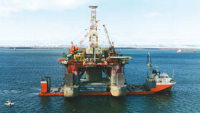What's happening in drilling
Drilling activity looking better at year-endSalomon Smith Barney’s November 19 Drilling Permit Update has some data that bodes well for the U.S. industry. The firm’s analysis of adjusted U.S. well permit applications, for 29 states, from January 1994 through October 1999 – as generated from various state agency sources – shows October’s drilling permits up 17.6% from September and 67.6% from October 1998. A plot of monthly unadjusted permits from January 1994 shows the rising 1999 numbers exceeding falling 1998 numbers in August of this year, then rising above even 1997 levels in September. October’s 3,215 U.S. permits is the highest monthly number for the five-year period. And the trend is up, from a low of 1,476 in January 1999. By state, Texas leads the nation with 3,215 permits in October; followed by Wyoming (809); Oklahoma (280); California (240); Kansas (144); Louisiana (116); and Montana (98). Salomon concludes that, "The recent sequential and year-over-year changes in the data suggest an increase in drilling activity in the coming months." It’s good to finally see some curves going up. But bad news for coalbed methane. In IADC’s November Drill Bits, an article reports that an issue that has been brewing for 10 years in Alabama now threatens coalbed methane development and hydraulic fracturing throughout the U.S. In 1989, a family living near the River Gas coalbed methane development in Tuscaloosa County, Alabama, teamed with the Legal Environmental Assistance Foundation (LEAF) to challenge coalbed methane operations. They charged that nearby hydraulic-fracturing activity had contaminated a water well located on family property. LEAF alleged, in a 1994 petition to EPA, that the Alabama underground injection control (UIC) program was deficient because it failed to regulate hydraulic fracturing of coalbed methane gas wells. Current EPA regulations do not consider hydraulic fracing to be "injection" as defined in the UIC program and, therefore, EPA does not require states to regulate this activity. But the 11th Circuit U.S. Court of Appeals agreed with LEAF in August 1997, and remanded the petition to EPA for action consistent with its decision. The article says EPA suggested changes to Alabama’s regulations for hydraulic fracturing, including a requirement that all material used cannot exceed maximum contaminant level standards established for drinking water under the Safe Drinking Water Act. The changes also would prohibit all upward fluid movement in the formation being fraced. IADC says, if adopted, these requirements would create the potential for application elsewhere in the U.S. EPA has stated, in public meetings, that it would be unfair to apply a standard to Alabama that did not apply elsewhere. Also, the court’s decision does not limit itself to coalbed methane. Rather, it made a broad statement that hydraulic fracturing should be regulated as "underground injection." This could easily affect other formations, such as tight gas well, Devonian shale wells and oil wells, IADC speculates. This impasse has virtually shut down new coalbed methane projects in Alabama. Unless EPA relents, or Congress excludes hydraulic fracing from the Safe Drinking Water Act, the renewed robust drilling activity in the Rockies, in particular, could be seriously threatened. IADC and the Domestic Petroleum Council are attempting to persuade EPA to return to its original interpretation of the Act or, at a minimum, to the original interpretation while further studies are conducted. If that strategy proves unsuccessful, the associations will aggressively pursue remedial legislation in Congress. For more information, IADC says, call Brian T. Petty, 1 202 293 0670. World-record heavy-lift load. On November 11, Dockwise’s Mighty Servant 1 heavy-lift vessel set out from Davie Industries, Quebec City, Canada, carrying the 31,183-t Petrobras 36 offshore oil and gas platform (formerly the Spirit of Columbus semi rig), bound for Brazil.
The semi has been in Quebec City for two years, being upgraded by Davie. In Petrobras’ Roncador field, 230 mi offshore, it will produce 180,000 bopd and 250 MMcfd gas in water depths of 4,430 ft. This will bring the field into production in a little more than three years from discovery. Davie’s two clients in the project are Brazil’s Petrobras and Maritima. Expensive drillships. In what appears to be a rather complicated arrangement, Global Marine says it has reached an agreement with Harland and Wolff Shipbuilding and Heavy Industries Ltd. regarding terms under which the builder will complete Global’s two new, ultra-deepwater drillships, Glomar C. R. Luigs and the Glomar Jack Ryan, at the builder’s yard in Belfast, Northern Ireland. Global has agreed to provide additional funding to ensure completion by the builder and its parent, Fred. Olsen Energy ASA. Global will give the builder access to $40 million. It will further advance it $93–$106 million above the ships’ $315 million contract price; and Olsen will kick in about $5 million. Not in the agreement are some claims for "amounts in excess of the contract price," which the builder says total $216 million. Global says these will be resolved by arbitration. Expected delivery dates are first-quarter 2000 for Luigs
and third quarter for Ryan. Copyright © 2000 World
Oil |
- Applying ultra-deep LWD resistivity technology successfully in a SAGD operation (May 2019)
- Adoption of wireless intelligent completions advances (May 2019)
- Majors double down as takeaway crunch eases (April 2019)
- What’s new in well logging and formation evaluation (April 2019)
- Qualification of a 20,000-psi subsea BOP: A collaborative approach (February 2019)
- ConocoPhillips’ Greg Leveille sees rapid trajectory of technical advancement continuing (February 2019)




